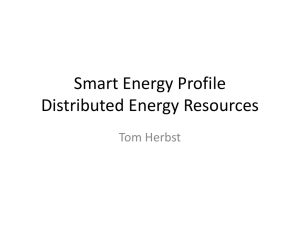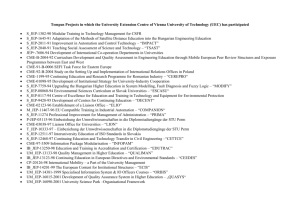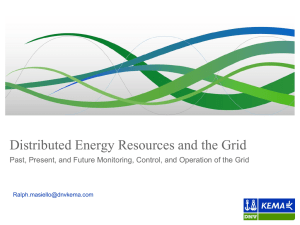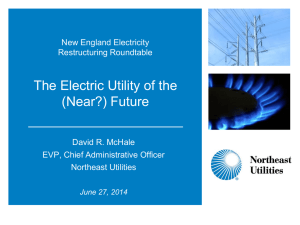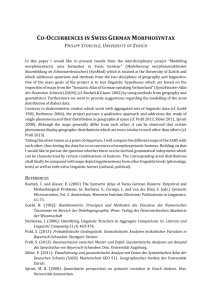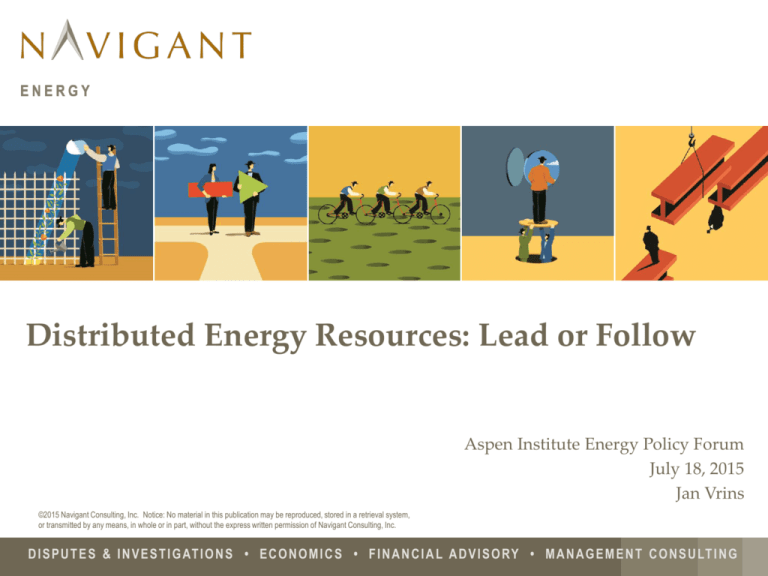
Distributed Energy Resources: Lead or Follow
Aspen Institute Energy Policy Forum
July 18, 2015
Jan Vrins
©2015 Navigant Consulting, Inc. Notice: No material in this publication may be reproduced, stored in a retrieval system,
or transmitted by any means, in whole or in part, without the express written permission of Navigant Consulting, Inc.
D I S P U T E S & I N V E S T I G AT I O N S • E C O N O M I C S • F I N A N C I A L A D V I S O RY • M A N A G E M E N T C O N S U LT I N G
Agenda
»
The Energy Cloud
»
What is happening with DER?
»
Utility Business Models
»
Closing Remarks
1
©2015 Navigant Consulting, Inc. All rights reserved.
THE ENERGY CLOUD
Transformation of the Power Industry—Key Trends
Four key trends underpin this market transformation:
–
–
–
–
Increased broad discussion, development, and implementation of new
regulations to reduce carbon emissions
Transition toward an increasingly decentralized power grid architecture as a
result of a dramatic rise in renewables and distributed energy resources (DER)
Greater customer choice: More customers want control over their electricity
usage and spend, as well as when and what type of power they buy—or, in
some cases, customers want the ability to self-generate and sell that power
back to the grid
Increasing availability of data enabled by healthy growth of smart grid
infrastructure and behind-the-meter technologies and solutions
The energy cloud represents a wide range of strategic, operational,
technological, commercial, environmental, and regulatory changes that
are transforming the traditional utility model for energy provision.
2
THE ENERGY CLOUD
Unlocking DER and Many-to-Many Energy Networks
TODAY: ONE-WAY POWER SYSTEM
EMERGING: THE ENERGY CLOUD
POWER PLANT
TRANSMISSION &
DISTRIBUTION
RESIDENTIAL
COMMERCIAL
INDUSTRIAL
©2014 Navigant Consulting, Inc. All rights reserved.
• Large, centrally located generation
facilities
• Designed for one-way energy flow
• Controlled by incumbents
• Technologically inflexible
• Simple market structures and
transactions
• Highly regulated (rate base) and pass
through
3
©2014 Navigant Consulting, Inc. All rights reserved.
• Widespread adoption of DER
• Supporting two-way energy flows; plug-and-play emphasis
• Digitalization of the grid and advanced planning and
monitoring of power demand and supply
• Flexible, dynamic, and resilient
• Advanced business models and new products and services
• Complex market structures and transactions
• Regulation changing rapidly around renewables, distributed
generation (solar, microgrids, storage), net metering, etc.
THE ENERGY CLOUD
Defining Distributed Energy Resources (DER)
Distributed Energy Resources is one of the most disruptive factors
affecting the Grid today and into the future.
Distributed Generation
•
•
•
•
Solar
Wind
Turbines / Micro Turbine
Fuel Cells
Distributed Storage
•
•
•
Electrochemical
Mechanical
Thermal
Microgrid
•
•
On the Grid
Customer
Demand Response
•
•
•
•
Direct Load Control
Price Based
Incentive Based
Virtual Power Plants
Utility Side Loss Reduction
•
•
•
Conservation Volt Reduction
Volt/VAR Optimization
Grid Optimization
Electrification
•
•
EV Charging and impact
EV to Grid
Resources can be utility owned on the grid “in front of the meter” or customer
owned “behind the meter”.
4
Agenda
»
The Energy Cloud
»
What is happening with DER?
»
Utility Business Models
»
Closing Remarks
5
©2015 Navigant Consulting, Inc. All rights reserved.
WHAT IS HAPPENING WITH DER
Tipping Points
» DG new build will be larger then centralized generation from 2018
onward.
DG solar installed cost to drop to less than $3/Watt for residential PV
and less than $2/Watt for commercial PV by 2020.
Price of utility scale installed solar reaching < $40/MWh in U.S.,
expected to be $20-10/MWh within the next 3-5 years.
Storage will be a game changer, investments in storage are projected to
exceed $6 billion by 2020.
AB327 – DRP, AB2514, DR, Rule 21 are driving significant
transformation in California; REV doing the same in NY.
Carbon regulations are shifting the investment landscape toward
efficiency and DR DER.
In response to weather-related electricity systems outages,
States like NJ, NY, CT are adopting policies that support
DER, e.g. microgrids.
»
»
»
»
»
»
6
©2014 Navigant Consulting, Inc. All rights reserved.
WHAT IS HAPPENING WITH DER
Solar Cost Forecast
Navigant forecasts the US installed DG solar cost to drop to less than
$3/Watt for residential PV and less than $2/Watt for commercial PV by 2020.
Commercial Solar PV Price Forecast, 20132020
Residential Solar PV Price Forecast, 20132020
5.00
7.00
$/Watt
$/Watt
6.00
5.00
4.00
3.00
3.00
2.00
2.00
1.00
1.00
0.00
0.00
2012 2013 2014 2015 2016 2017 2018 2019 2020
Mid
High
(Source: Navigant, Jan. 2015)
7
4.00
Low
2012 2013 2014 2015 2016 2017 2018 2019 2020
Mid
High
Low
WHAT IS HAPPENING WITH DER
Solar Outlook
Navigant forecasts the total US installed solar capacity to be close to 65,000
MW by the end of 2020 of which 55% distributed. This assumes ITC will not be extended.
U.S. Cumulative Capacity, by System Type (MW)
(Source: Navigant, Jan. 2015)
Note: Distributed is defined as projects < 1 MW whereas centralized is defined as projects ≥1 MW
8
©2015 Navigant Consulting, Inc. All rights reserved.
1
WHAT IS HAPPENING WITH DER
Solar in Texas
Austin Energy Solar RFPs <$40/MWh in June 2015
Barilla Solar – 1st US Merchant Plant
Source: First Solar
Source: Austin Energy, June 30, 2015
•
22 MW merchant plant – sells power into
ERCOT wholesale market
Owned by First Solar
Commissioned 2014
Located in Webberville, TX
•
•
•
9
•
•
•
Signed a $45/MWh PPA for 150 MW solar farm
with Recurrent Energy in March 2015
Obtained bids of <$40/MWh in June 2015 for 600
MW of solar
By 2020, Austin Energy forecasts pricing of
<$40/MWh without ITC, and <$20/MWh with ITC
WHAT IS HAPPENING WITH DER
Energy Storage Cost Forecast
Cost reductions are expected across all technologies, with the largest
percentage reductions expected for Li ion and flow batteries.
Lowest Installed Cost for Utility Applications 2014, 2017, 2020
$700
$600
$/kWh
$500
$400
$300
$200
$100
$-
2014
Lithium Ion
Sodium Sulfur
2017
Sodium Metal Halide
Source: Navigant Research
10
2020
Advanced Lead-Acid
Flow Batteries
WHAT IS HAPPENING WITH DER
Energy Storage Outlook
Navigant forecasts the total US installed energy storage capacity to be close to
6,000 MW by the end of 2020 of which ~40% distributed.
U.S. Cumulative Capacity, by System Type (MW)
1
Cumulative Capacity, MW
7,000
6,000
Distributed
5,000
Utility-Scale
4,000
3,000
2,000
1,000
2015
2016
2017
2018
2019
2020
2021
2022
2023
(Source: Navigant, Jan. 2015)
Note: Distributed is defined as systems located through the Distribution System (substation down to the customer, including “community storage”).
11
©2015 Navigant Consulting, Inc. All rights reserved.
2024
WHAT IS HAPPENING WITH DER
Rate of DG Capacity Deployments Is Accelerating
Between 2014 and 2023, DG is expected to displace the need for 300–350 GW of new
large-scale power plants globally.
Annual Centralized Power Plant and DG Capacity Additions
and Vendor Revenue, World Markets: 2014-2023
Annual New Centralized Power Plant Capacity Additions
Annual New Distributed Generation Capacity Additions
Annual Distributed Generation Revenue
180
$200,000
$180,000
160
$140,000
(GW)
120
$120,000
100
$100,000
80
$80,000
60
$60,000
40
(Source:to
Navigant
Research)
New DG capacity expected
surpass
centralized generation in 2018
20
0
$20,000
$-
2014
12
$40,000
2015
2016
2017
2018
2019
2020
2021
2022
2023
($ Millions)
$160,000
140
Agenda
»
The Energy Cloud
»
What is happening with DER?
»
Utility Business Models
»
Closing Remarks
13
©2015 Navigant Consulting, Inc. All rights reserved.
UTILITY BUSINESS MODELS
State Proceedings Impacting Utility Business Models
In several states, proceedings are underway that will impact industry
structure, and business model boundaries for utilities.
New York REV Proceeding
• Industry Structure Elements: Regulatory changes that promote efficient use of energy,
deeper penetration of renewable energy resources such as wind and solar, and increased
DER deployment.
• Key Questions: What are the roles and responsibilities of the regulated utilities and
retail markets? What changes are necessary to align utility interests with these
objectives?
California Initiatives (AB327 – DRP filing, AB2514, DR, Rule 21)
• Industry Structure Elements: Enablement of retail entities to receive appropriate
locational value for DER implementations through integration of DER into local system
planning, established procurement targets for Energy Storage, movement of DR into
wholesale markets, fast track approval of DER/energy storage equipment, and increased
data accessibility.
• Key Questions: How should utilities modify system planning to optimize DER
deployment? How to quantify locational based benefits and costs? Will energy storage
add value to system operations? How fast can new devices enter the marketplace?
14
UTILITY BUSINESS MODELS
State Proceedings Impacting Utility Business Models
Hawaii Legislative Policy
• Industry Structure Elements: Allow customer-owned generation resources at all points
in a timely manner and at reasonable cost.
• Key Questions: What level of market acceptance will this new policy engender and will
it adversely effect rate recovery?
Massachusetts Grid Modernization
• Industry Structure Elements: Enable grid design that “maximizes integration of
renewable power, much of which is intermittent.”
• Key Questions: How will the utility incentive structure and utility cost recovery
mechanism change to enable achievement of this policy?
15
UTILITY BUSINESS MODELS
Emerging Utility Business Models
Model
Utility as
DSO
Description
•
•
•
Utility owns the distribution assets, makes
allowable investments based on DSO planning
process.
Utility acts as independent DSO, and conducts
market operations (market facilitation of DER and
transaction management).
Utility as DSO also conducts physical operations
(real and reactive power flow, outage restoration,
switching, reliability coordination, situational
awareness).
Third-Party • Utility owns the distribution assets, makes
allowable investments based on DSO planning
DSO
•
•
16
process.
Third-party DSO conducts market operations
(market facilitation of DER and transaction
management)
Third-party DSO may also conduct physical
operations (real and reactive power flow, outage
restoration, switching, reliability coordination,
situational awareness)
Examples
NY REV proposal
NY REV proposal
UTILITY BUSINESS MODELS
Emerging Utility Business Models
Model
ValueAdded
Service
Provider*
Description
•
In addition to any of the roles described in
previous slide, the utility is allowed to provide
additional value-added services that may or may
not be related to DER, such as:
― Behind-the-meter energy services (e.g., home
energy management)
― Premium (i.e., higher reliability/quality) power
supply
― Warranties, financing for DER
― Ownership/operation of electric vehicle (EV)
charging stations
― Operations and maintenance of third-party owned
DER
― Community based solar or wind
Examples
OG&E, NV Energy,
BG&E home energy
management
programs, TEP
(rooftop and
community PV),
PG&E (EV charging
stations, pilot)
* May be combined with any of the above business models.
While some business model constraints are imposed, remaining business
model choices should be informed by the utility’s value proposition, risk
profile, and growth aspirations .
17
UTILITY BUSINESS MODELS
Utility Business Model Selection
Utilities can select from a variety of business models related to DER.
Development and Ownership Model Selection
Model
Selection Rationale
1. Integrate,
develop, and
own DER
Utility has DER integration experience
and has no difficulty with designing,
integrating, and controlling with inhouse resources.
2. Develop and
own DER
Utility has the in house capability to
handle permitting, site selection,
financing, and interconnection.
3. Purchase a
turnkey solution
Due to DER specific knowledge, it may
be more economical to have a third
party handle the project development
and site preparation tasks.
4. Contract
services
Due to the regulatory environment,
utility contracts services from 3rd
Parties.
18
Knowledge
Transfer
Time &
Resources
High
knowledge
transfer
High level
of
investment
High risk
Least
knowledge
transfer
Low level of
investment
Relatively
low risk
Risk
UTILITY BUSINESS MODELS
What have we learned from other industries
University of Pennsylvania’s Wharton School Study: reviewed S&P 500
companies to see how valuations trends have evolved along with
business models and emerging technologies.
Study identified four business models :
Asset Builders
Service Providers
Technology Creators
Network Orchestrators
Network Orchestrators : These companies create a network of peers in which the
participants interact and share in the value creation. They may sell products or services,
build relationships, share advice, give reviews, collaborate, co-create and more. Examples
include eBay, Red Hat, Visa, Uber, Tripadvisor, and Alibaba. They are more profitable and
grow faster. And they have higher return on assets and lower marginal costs.
Who will be the network orchestrators of the Utility industry?
19
Agenda
»
The Energy Cloud
»
What is happening with DER?
»
Utility Business Models
»
Closing Remarks
20
©2015 Navigant Consulting, Inc. All rights reserved.
Closing remarks
» The Energy Cloud is here to stay, DER will be one of the most disruptive
»
»
»
»
»
»
factors affecting our industry
DER pushing center of gravity of the
DER and
Generation
Transmission
Distribution
Retail
electricity value chain downstream
Markets
Market rules and regulation will try to keep pace with technology and
customer choice, but we are not optimistic more periods of
uncertainty and chaos.
Role of the Utility is key : they are taking both defensive and offensive
positions to adapt to DER opportunities and threats
Utilities will be impacted - strategy and business models, but more so
operations, organization and culture
Significant investments will be needed in the grid to support DER
– Who will pay?
– How to balance customer choice, cost and reliability?
This is not just about Hawaii, California and NY anymore
21
©2014 Navigant Consulting, Inc. All rights reserved.
C O N TAC T S
Key
CON&
TACTS
RESOURCES
Jan Vrins
Global Energy Practice Leader
Navigant Consulting, Inc.
305.341.7839 office
jan.vrins@navigant.com
@Jan_Vrins
Navigant Energy Practice
http://www.navigant.com/industries/energy
Navigant Research
http://www.navigantresearch.com/research
©2010 Navigant Consulting, Inc.
©2015
Confidential and proprietary. Do not distribute or copy.
22
ENERGY

